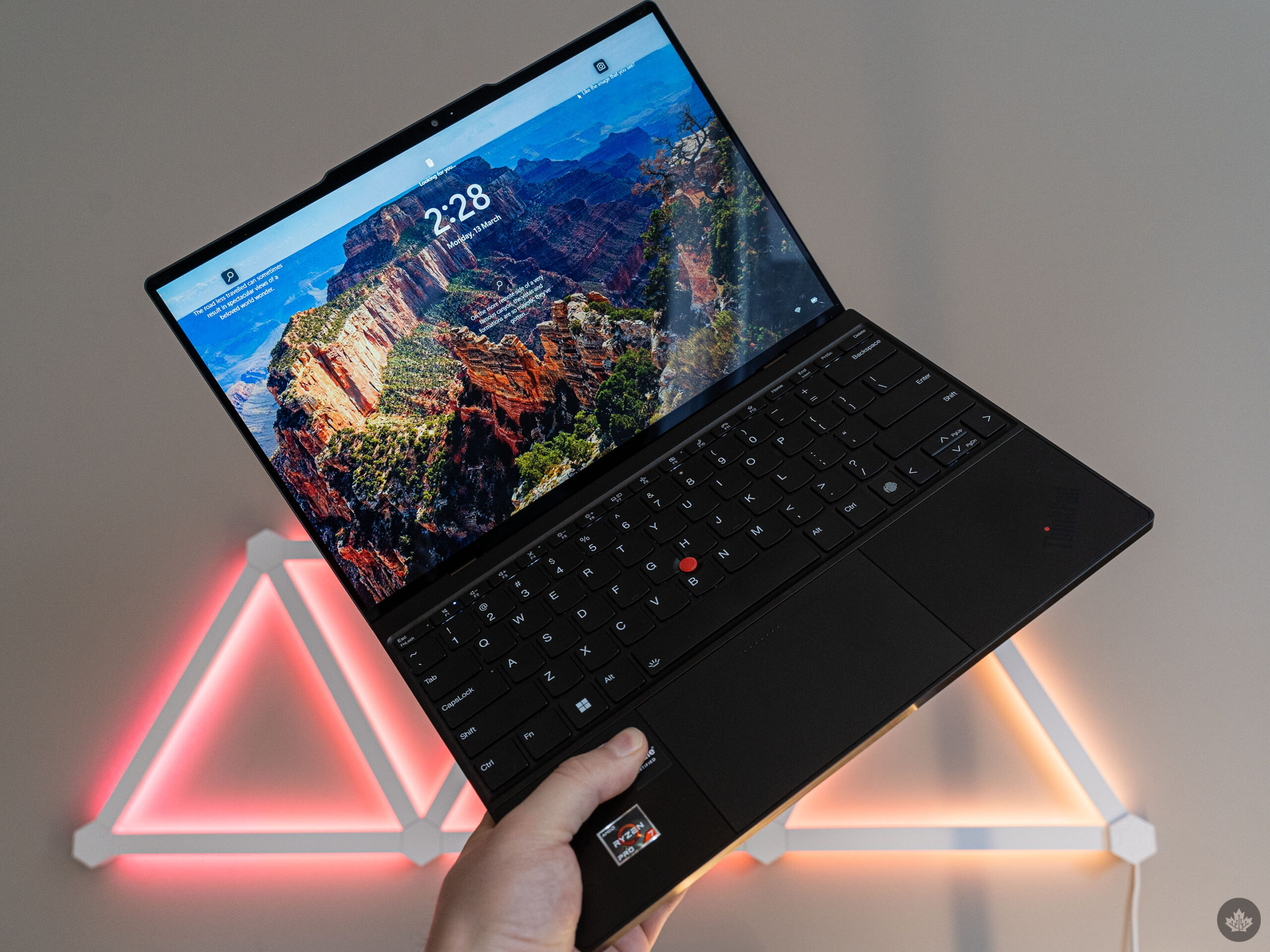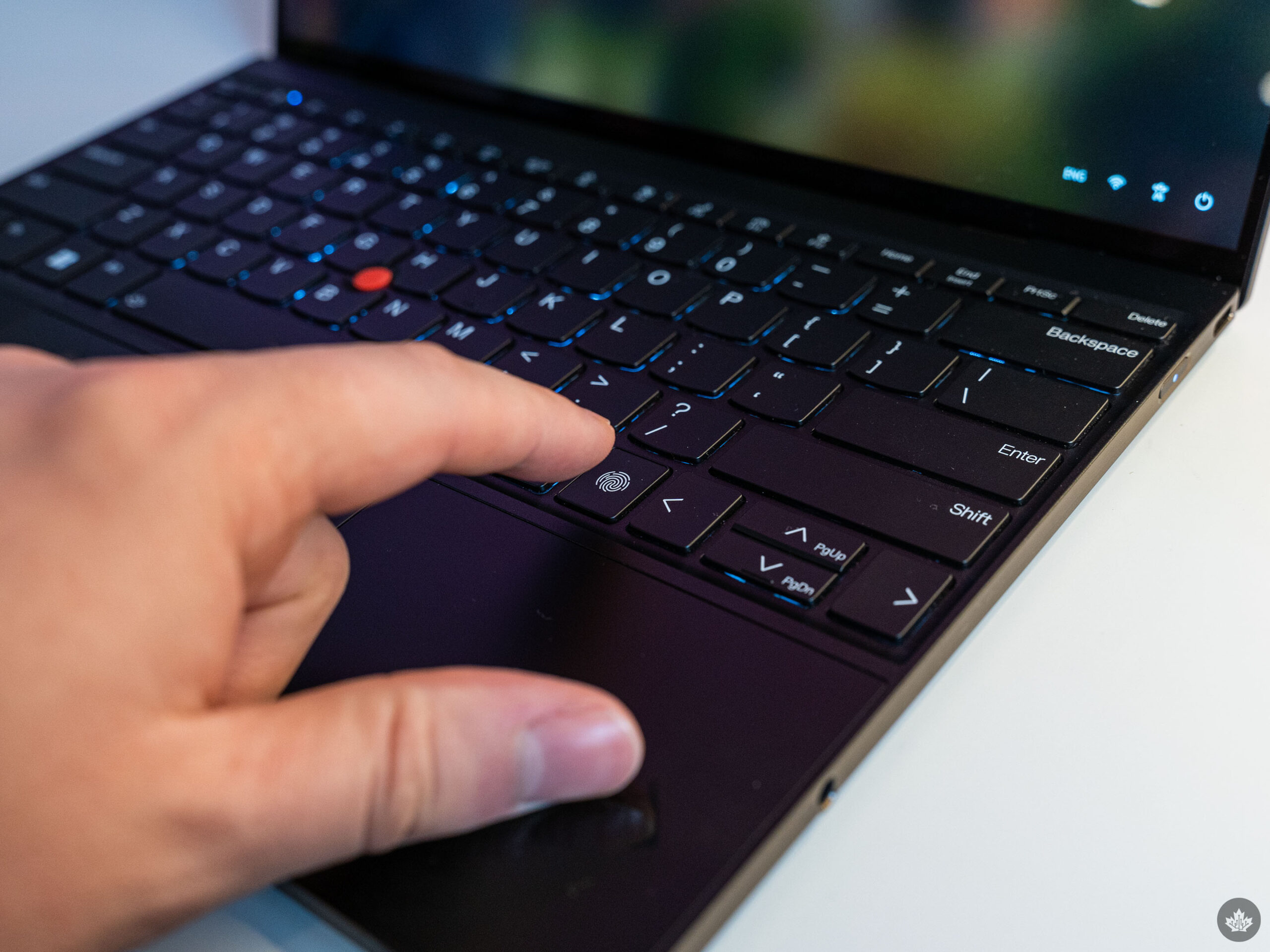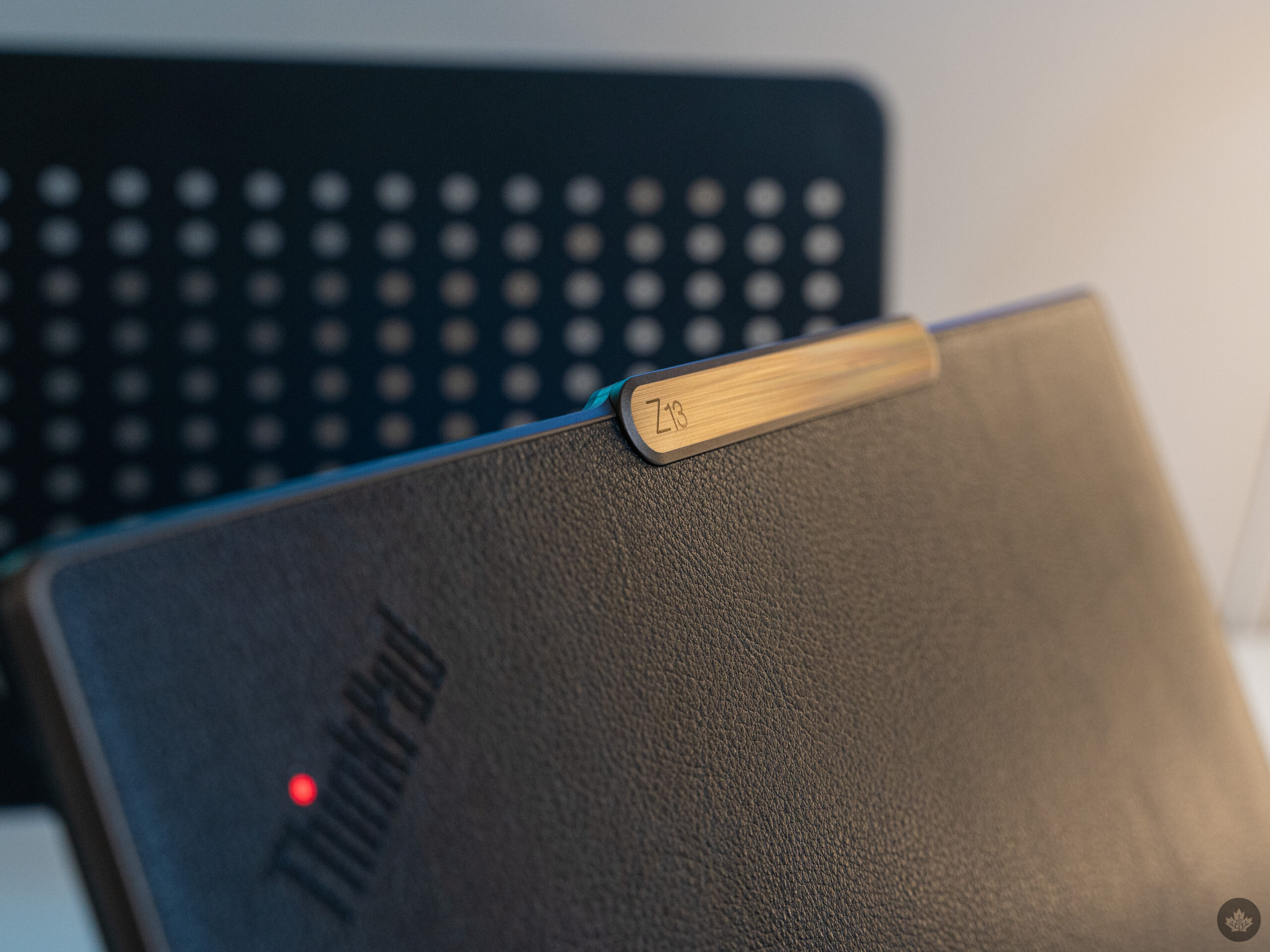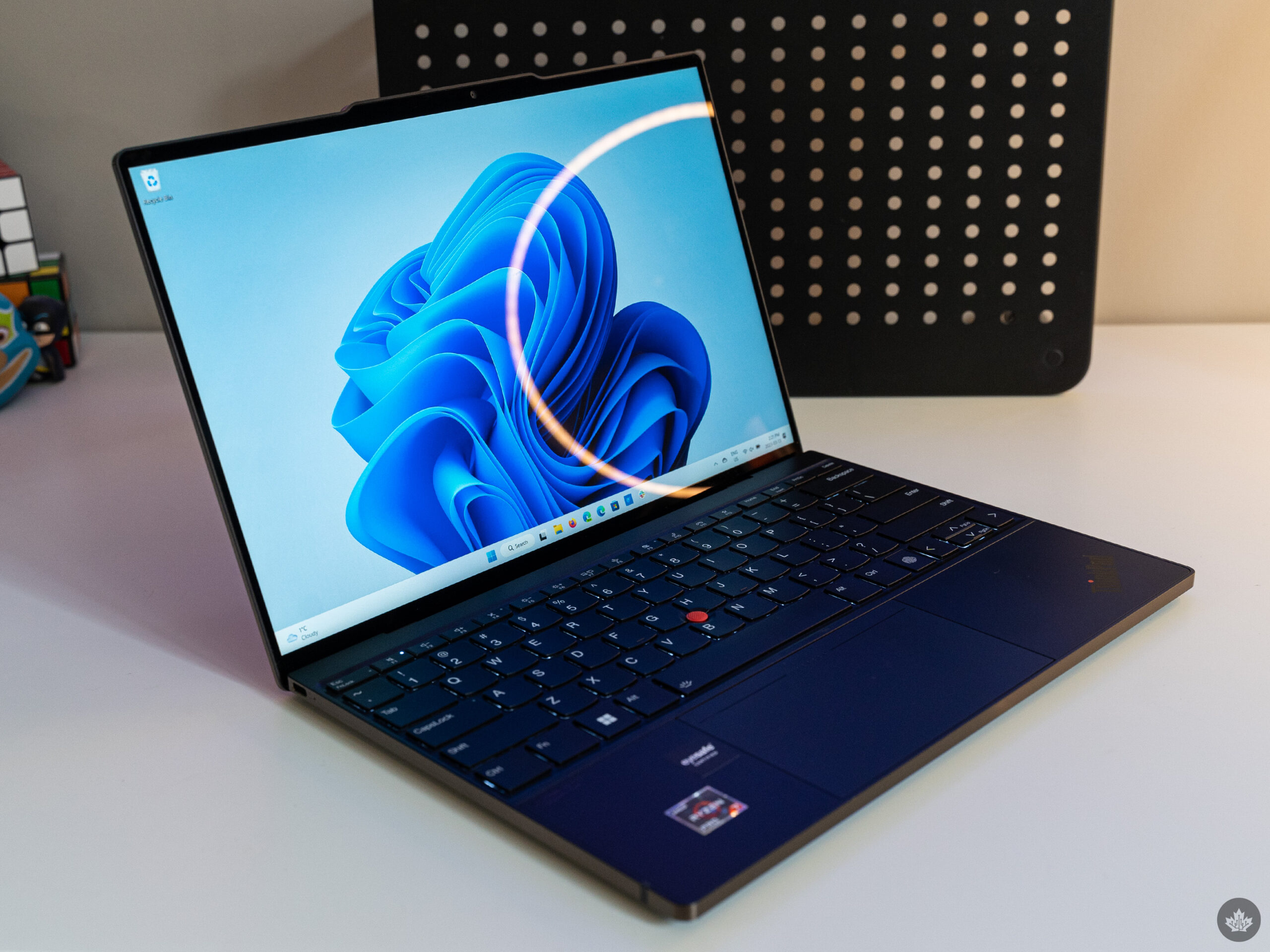
The Pros
- Great design
- Solid performance
- Portable package
The Cons
- Mediocre battery life
- Pixelated webcam
- Limited ports
Lenovo releases tons of laptops under various banners – ThinkPad, ThinkBook, IdeaPad, etc. – every year. Last year’s excellent ThinkPad Z13, is one of my favourites from Lenovo’s 2022 lineup.
The ThinkPad Z13 boasts an excellent design, premium construction, and solid performance in an extremely portable package. Moreover, I tested out the ‘Aluminum + Bronze’ variant of the Z13, which sports a lid coated with black ‘vegan leather.’ While the leather doesn’t do much for me, the bronze accents on the edges of the Z13 help contribute to its overall excellent aesthetics.
Given my experience with typical Lenovo laptops, I’m frankly shocked by how much I like the Z13’s design. Most ThinkPads and ThinkBooks I’ve tried offered boring designs with plain exteriors, often composed of grey aluminum. There’s nothing wrong with that, but it’s nice to have access to laptops that add even small flourishes to elevate the experience.
Along with good looks, the ThinkPad Z13 manages to be a reliable laptop too. I was well pleased with the performance of the AMD Ryzen 7 chipset in my review unit, and the Z13 became my daily driver for several weeks, both when working remotely and when in the office. The Z13 even enabled some light gaming, though I wouldn’t recommend it as a gaming machine.
Not everything is perfect, of course, but there’s enough right that I’d feel comfortable recommending the ThinkPad Z13 to those who need a petite package packing plenty of performance.
Specs

- Display: 13.3-inch 1920 x 1200 pixel IPS, 400 nits, low blue-light
- Processor: AMD Ryzen 7 Pro 6850U
- Memory: 16GB
- Storage: 512GB SSD
- Dimensions: 13.99mm x 295mm x 200mm / .55″ x 11.59″ x 7.86″
- Weight: Starting at 1.26kg / 2.78lbs
- Camera: 1080p hybrid with IR and E-camera shutter
- Operating System: Windows 11
- Battery: 51.5Wh last up to 18.3 hours in Lenovo testing
- Connectivity: Wi-Fi 6E 802.11AX (2 x 2), Bluetooth 5.1
- Sensors: Fingerprint sensor,
- Ports: 2 x USB-C 4, 1x headphone/mic jack
- Graphics: AMD Radeon Graphics
Note: The above specs correspond to my particular review unit. You can find a full list of specifications for various configurations of the ThinkPad Z13 here.
Ryzen doesn’t disappoint

Most laptops I review include Intel chips, but whenever an AMD-powered laptop crosses my desk, it seldom disappoints.
The Z13’s Ryzen 7 Pro 6850U continued that trend, offering solid performance ahead of some comparable Intel and even Apple M-series chips. However, the Ryzen 7 also sports the same drawback I encountered with other AMD-powered devices: performance tanks when running on battery.
In real-world use, I found the reduced performance wasn’t that noticeable in most cases. Given the choice, I’ll take the reduced performance for the improved battery life (though it’s still far from great). The performance hit is most evident in benchmarks, which don’t always reflect real-world use. In most cases, I ran the ThinkPad Z13 plugged in with the power settings set to ‘best performance,’ but on the days when I go into the office, I’m able to use the Z13 all day on the ‘Balanced’ mode without the battery dying.
My typical workflow involves tons of browser tabs opened across as many as three browser windows, Photoshop, Slack, listening to Spotify and more. Through most of my testing, I used the Firefox browser, but more recently, I’ve been running Edge to get access to Bing Chat. I didn’t notice any significant change to battery life running Edge compared to Firefox.
One final note on performance, the Z13 can handle some light gaming – emphasis on light. I played some Civilization VI with my wife using the laptop while connected to our TV. It did all right, running at 4K and a solid 30fps. While I’d prefer 60fps+, 30fps was fine for what we were doing and I was mostly impressed by how well the Z13 handled it, though it did get quite warm after longer sessions (just one more turn).
Surprisingly high-quality

Moving on to the Z13’s display, I was again impressed by what was offered, even if it wasn’t the best. My review unit has a 13.3-inch 1920 x 1200 pixel resolution IPS display with up to 400 nits brightness. While the specs could be better – higher resolution, brighter, OLED – I still found the Z13’s display was excellent.
Colours are vibrant, and the screen is plenty bright in most circumstances. I only had an issue with the brightness when using the screen in direct sunlight (but that’s an area where most screens will struggle).
Of course, the display isn’t the only part of the Z13 that impressed me. The laptop offers excellent input options with a solid keyboard and trackpad. Again, the keyboard isn’t the best I’ve used on a laptop, but it still works well, and I don’t mind typing on it (which is always good when a good portion of your job involves writing). My only complaint about the keyboard is that the delete key sometimes sticks, which resulted in me deleting more text than intended on multiple occasions.
The trackpad is decently large for a laptop of this size. As usual, I’d love to have a larger touchpad, but what’s present on the Z13 is sufficient. Lenovo describes it as a “glass haptic” touchpad, and it honestly feels superb. Plus, for a trackpad using haptics, it’s surprisingly clicky.
Interestingly, the Z13’s palm rest uses a similar material as the trackpad. It feels very premium, but it seems somewhat odd. There’s a split between where the trackpad ends and the palm rest begins so people don’t accidentally try using the palm rest as the trackpad. It’s like a half-step toward something like the new Dell XPS laptops with a single slab of glass that makes the palm rest look like one big trackpad. While I haven’t tried the new XPS myself, the Z13’s approach to the glass trackpad sacrifices aesthetics for a more usable input, which is probably the right move.
Leather up, losers

While the Z13’s trackpad/palm rest situation may not be the most aesthetic, the laptop's overall design is quite nice. I’m a big fan of the bronze accents and the ‘vegan leather’ lid. Overall it feels like Lenovo paid attention to the details with the Z13, and it ultimately paid off.
There are several tiny details that, while not critical to the overall experience, elevate the Z13. For example, the ‘ThinkPad’ logo on the lid features a red dot over the ‘i’ that lights up when the laptop is on. It’s subtle, and not having it would make no difference to the overall experience, but it’s a nice touch.
Similarly, the Z13 sports a small protrusion above the display. It’s a little space for the webcam and Windows Hello sensors, almost like a reverse notch that sticks up from the top of the laptop instead of extending down into the display. However, the protrusion doubles as a lip to open the lid of the laptop. Again, subtle but a nice touch. That said, I wish Lenovo had kept the physical camera shutter on the Z13. There is a button to disable the camera, but I prefer having the physical shutter instead.
It’s worth noting that the bronze and vegan leather design costs extra. The default for the Z13 is a boring ‘Arctic Grey’ aluminum chassis, though that might be good news for those who don’t prefer the leather lid or just want to save some money. The leather costs an extra $57 and is only available on certain configurations of the Z13. In other words, you’ll need to pay for a higher-end variant of the laptop on top of paying the extra $57 for the leather and bronze design.
Imperfections and price shenanigans

Naturally, not everything with the Z13 is perfect. I encountered a strange issue where the laptop would beep after several keystrokes. It was pretty inconsistent and only seemed to happen if I did several keystrokes in rapid succession. I eventually figured out it was an intentional feature, annoying as it was. Worse, I had to dive into the BIOS to turn it off. Why on earth is it on by default, and why is there no option in the regular settings menu to change it? It’s beyond me.
I also found the webcam to be mediocre at best. Of course, I don’t think there’s ever been a good webcam, but it’s worth noting that the only positive thing to say about the Z13’s webcam is that it’s there.
There’s also some bloatware to contend with, though I didn’t find the Z13 situation to be overly egregious, and if you’re willing to take the time (and you should), you can remove most of the unwanted apps fairly quickly and easily.
Additionally, the Z13 has decent speakers if you like listening to things without headphones.
Finally, it’s worth taking a moment to go over pricing because, as with most Lenovo laptops, things get a little weird. Lenovo’s website lists two preset configurations and then a build-your-own option. Of the pre-configs, you’ll be looking at at least $1,858.35 for the Z13, though Lenovo claims the laptop is currently 35 percent off and normally costs $2,859. That’s frankly too much for what you’re getting.
Oddly, if you build your own, the price goes up to $2,889 for the base config but the discount also goes up to 39 percent, which means you end up paying $1,762.29. The configuration I reviewed with the vegan leather costs $3,557 or $2,169.77 with the 39 percent discount at the time of publication.
However, Lenovo’s prices seem to fluctuate often with sporadic deals and discounts. My recommendation for anyone interested in the Z13 would be to watch for a top-notch offer and scoop up the laptop when it’s available for a steal.
The Z gets and A
Price shenanigans aside, I really like Lenovo’s ThinkPad Z13. It meshes style and portability in a unique way, while also offering solid performance and decent battery life. Though not perfect, the Z13 gets enough right and is genuinely a joy to use.
I’d recommend the Z13 to anyone looking for a stylish laptop to handle their work needs. The Z13 truly is a workhorse of a laptop and manages to get it done while looking good. Plus, I appreciate the compact size and weight for when I need to take it on the go.
At the same time, things I like about the Z13 could be drawbacks for others. The small size means a small, 13.3-inch display, which could feel restrictive for some workflows. Similarly, only having two USB-C ports could be frustrating for some, though it wasn’t a major issue for me.
You can purchase the ThinkPad Z13 from Lenovo’s website.
The Z13 truly is a workhorse of a laptop and manages to get it done while looking good.
MobileSyrup may earn a commission from purchases made via our links, which helps fund the journalism we provide free on our website. These links do not influence our editorial content. Support us here.


